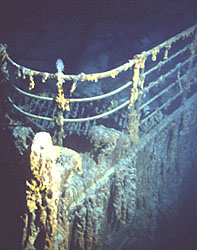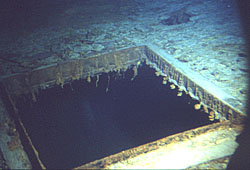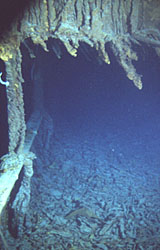

| |
| Diving for Diamonds | September 20, 2000 |
| by Ricardo J. Elia | |
The ongoing saga of the RMS Titanic and efforts to protect shipwrecks and submerged sites

Bow of RMS Titanic (© James Delgado)
This was to be a summer of big profits for the new management team at RMS Titanic, Inc., which took control of the company in November, 1999 after a shareholder coup removed George Tulloch, the salvage firm's president, and Allan Carlin, its general counsel, in an effort to accelerate the salvaging of artifacts from the site of the oceanliner, which was sunk by an iceberg on its maiden voyage in the North Atlantic on April 15, 1912.
Led by new president Arnie Geller and chief operating officer G. Michael Harris, a former entertainment agent who once promoted dwarf-tossing acts in bars, this summer's expedition to the Titanic site aggressively planned to target high-profile and valuable artifacts in what would be "the most ambitious deep-sea exploration and recovery venture ever mounted." Among the stated targets for the summer of 2000 was a diamond shipment worth $300 million today--a shipment that some historians insist was never on board when the Titanic sank.
Previous expeditions, which have recovered more than 5,000 artifacts since 1983, had collected items only from the debris field surrounding the wreck. This summer, for the first time, the salvage operation announced its intention to enter the cargo hold of the sunken oceanliner to retrieve objects. The plans were received with dismay by preservationists and archaeologists, who feared that this year's assault on the site would not just scavenge artifacts but might damage the fabric of the vessel. There were also fears that RMS Titanic would begin selling off recovered artifacts; for years the company has been selling coal from the site but has refrained from disposing of other items.
But like most treasure hunting enterprises, this summer's salvage expedition failed to match the hype of its promoters. First, the federal judge in Virginia who has been overseeing the salvors issued an order barring the RMS Titanic from cutting into the wreck or selling its artifacts. Then, plagued by bad weather and equipment failures, the project had only limited opportunities for plucking artifacts from the site during late July and August. The dull and spotty "daily" reports posted on the company's website betray this season's lackluster results. Even more revealing was the firing of expedition leader G. Michael Harris in a special board meeting at the end of project.
Protection or Plunder?
Short of praying for hurricanes and equipment failure, we do have some reason to be guardedly optimistic about the future of the Titanic and other underwater cultural heritage. Even as RMS Titanic, Inc. was preparing for this summer's expedition, the U.S. National Oceanic and Atmospheric Administration (NOAA) was seeking public comments on draft "Guidelines for Research, Exploration, and Salvage of RMS Titanic." The guidelines are intended to complement a draft international agreement concerning the Titanic that was negotiated by the governments of the United States, Canada, United Kingdom, and France between 1997 and 2000.
The impetus for a Titanic agreement was the RMS Titanic Maritime Memorial Act, a 1986 law that directed NOAA to enter into consultations with the countries mentioned above in order to develop international guidelines for research, exploration, and, if appropriate, salvage of the Titanic. The intention of Congress was to recognize the Titanic as an international maritime memorial, and to ensure the protection of its scientific, cultural, and historical significance.
The RMS Titanic Memorial Act also urged that, until an international agreement could be developed for the management of the site, "no person should conduct any research or exploration activity which would physically alter, disturb, or salvage the RMS Titanic."
NOAA's draft guidelines stress the importance of in situ preservation as the treatment of preference for the Titanic. Recovery of artifacts would be permitted only for educational, scientific, or cultural interests, and research activities must be based on a scientific research design, including plans for conservation, curation, and publication of the results.
Consistent with its mission of supporting the preservation of the world's archaeological heritage, the Archaeological Institute of America (AIA) submitted comments on the draft Titanic guidelines to NOAA in June 2000. AIA president Nancy Wilkie, describing the Titanic as "a significant archaeological, historic, and cultural site" that "should be preserved and managed in the public interest through a concerted international effort," expressed supported for the guidelines and draft international agreement. She also highlighted a few areas where the guidelines could be strengthened, for example by adding an express prohibition of commercial treasure hunting and requiring that projects be directed by a professional underwater archaeologist.
As might be expected, the salvage lobby has vehemently opposed the guidelines, fearing governmental regulation will replace the relative free-for-all environment of admiralty court. In April, 1999 RMS Titanic, Inc., as exclusive salvor-in-possession of the Titanic wreck, filed suit in federal court in Virginia seeking to block the U.S. State Department and NOAA from seeking to implement an international agreement that might diminish or divest the company of its rights to salvage the Titanic.
Whether profit or preservation will prevail at the Titanic site will depend on NOAA's assessment of the various comments it has received, and on the will of the United States, Canada, United Kingdom, and France to proceed towards implementation of the agreement.

Skylight of wireless room on RMS Titanic (© James Delgado)
Stormy International Seas
Most nations have laws regulating underwater cultural heritage in their territorial seas (which may extend to 12 miles from the coast). The United States, through its Abandoned Shipwreck Act of 1987 (ASA), regulates historic shipwrecks within a three-mile territorial sea. Beyond the territorial seas underwater sites lie in a free-for-all zone, where unregulated commercial salvage is the rule of the seas. That's just how the treasure hunters want to keep it.
International rules and principles relating to the seas are codified in the 1982 Law of the Sea Convention (LOS), which is now in force and ratified by 130 nations. The United States did not sign the original agreement in 1982 because of disagreements over seabed mining provisions, but after LOS was amended in 1994, it withdrew its objections and is moving to accede to the convention.
Unfortunately, the subject of underwater cultural heritage received only marginal consideration during the LOS deliberations. The final treaty includes a general provision calling on nations to protect "objects of an archaeological and historical nature found at sea" for the benefit of all mankind, and to cooperate in that effort. LOS also permits nations to take steps to protect submerged cultural resources within their contiguous zone (a band of sea contiguous to the seaward edge of the territorial sea and extending no more than 24 miles from the coast). Some nations currently protect underwater archaeological sites within the 24-mile zone, including Denmark, France, Tunisia, and China.
The position of the United States is somewhat anomalous. The Abandoned Shipwreck Act applies to the 3-mile territorial sea. In 1988, President Reagan extended the territorial sea to 12 miles, but the coverage of existing laws, like the ASA, were not extended at that time. At the same time, the United States has a contiguous zone from 3-12 miles. In 1999, President Clinton signed a proclamation extending the contiguous zone between 12 and 24 miles out from the coastline; the move was seen, in part, as an opportunity to protect of underwater cultural heritage in this area. Still, to date the United States has not taken steps to control underwater archaeological sites in the 3-12 mile zone, leaving submerged shipwrecks and other sites exposed to exploitation by treasure hunters.
The vulnerability of historic shipwrecks beyond the territorial sea is dramatically underscored by the fate of the 1733 Plate Fleet, a convoy of Spanish galleons that was destroyed by a hurricane in the Florida Keys. Most of these ships were subject to Florida's jurisdiction until a 1975 Supreme Court decision redrew the boundary between the Atlantic Ocean and Gulf of Mexico; in effect, the sunken fleet moved from state to federal waters. Unregulated treasure hunting soon led to the plundering of the wrecks, none of which were studied archaeologically. By 1980 Florida's state underwater archaeologist, William Cockerell, reported that "all known sites in the Florida Keys previously protected by state law were destroyed" by treasure hunters.
Beyond the contiguous zone, LOS recognizes coastal state jurisdiction over the continental shelf or exclusive economic zone (EEZ), for the purpose of controlling fisheries and other natural resources. LOS offers no protection to underwater cultural heritage in these zones, or in the high seas beyond them, other than a general duty among nations to protect archaeological sites in the public interest. Several states, however, including Australia, Ireland, Portugal, and Spain, have passed legislation protecting archaeological sites on their continental shelf.
The United States claims control of both the continental shelf and EEZ out to 200 miles from the coast. Most of this area is completely unregulated in terms of submerged archaeological sites. The Abandoned Shipwreck Act does not apply to these zones. The United States does, however, control underwater archaeological sites within the 200-mile EEZ in designated National Marine Sanctuaries. And federal agencies, like the Minerals Management Service, which operates minerals extraction leases in the outer continental shelf, require archaeological surveys to be conducted in compliance with federal preservation regulations.
The Draft Underwater Convention
By far the most positive development in years in the field of maritime preservation is the current effort, sponsored by the United Nations Educational, Scientific, and Cultural Organization (UNESCO), to produce an international agreement on the protection of underwater cultural heritage. This effort, which began as an initiative of the International Law Association, was inspired by an awareness of the growing threats to underwater archaeological sites, including shipwrecks, from unregulated commercial exploitation and other activities. The development of a new convention is regarded as urgent in light of the general absence of legal protection for sites in waters beyond the territorial seas, and also by the fact that ever-improving technology is making even the deepest wrecks accessible to plunder.
UNESCO began considering an underwater cultural heritage convention in 1995. A meeting of experts was held the following year to discuss a draft convention. Since then, three meetings of governmental experts have been held in Paris. Under the Draft Convention, a nation could regulate submerged cultural heritage in a number of ways. It could deny the use of its ports or facilities to those engaged in recovering sites contrary to acceptable, scienctific standards. It could deny entry of artifacts into its country if they were obtained in a manner inconsistent with those standards It could create a permit system to allow appropriate research and recovery efforts within the waters under its jurisdiction. And, perhaps most importantly, the Draft Convention permits coastal nations to extend their jurisdiction over underwater cultural heritage to their continental shelf/EEZ. This provision would give many nations the right to control archaeological sites within a 200-mile-wide zone.
The AIA has actively participated in the deliberations concerning the underwater convention for several years. In 1998, the AIA submitted written comments, expressing strong support for the idea of a convention to protect and manage submerged cultural heritage beyond the territorial seas. In June 2000, we submitted additional comments prior to the third meeting of governmental experts. Our position remains consistent--we support concerted, international preservation efforts and believe there is no place for commercial salvage of archaeological resources. And we believe that coastal states should take responsibility for the protection and management of submerged sites on their continental shelves.
 RMS Titanic promenade deck (© James Delgado) | Needless to say, the commercial salvage interests are strongly opposed to the Draft Convention. Treasure salvors prefer the status quo--i.e., virtually no government interference and the ability to obtain exclusive salvage rights or ownership of shipwrecks under admiralty law. They claim that they can be trusted to preserve the archaeological and historical values of wrecks without government interference. The position of the U.S. delegation is causing serious concern within the preservation community. The United States has a rather dismal record in previous international deliberations regarding cultural heritage. It refused to sign the 1954 Hague Convention for the Protection of Cultural Property in the Event of Armed Conflict because it would limit the military from maintaining a nuclear option; signed the 1970 UNESCO cultural property convention, but only after effectively limiting the essential provisions of the treaty; and has not signed the 1995 UNIDROIT Convention on Stolen and Illegally Exported Cultural Objects. In the current deliberations, the United States has criticized numerous provisions of the UNESCO draft and suggested alternate versions of many articles. It favors limiting the definition of underwater cultural heritage, which was broadly defined in the UNESCO draft, to objects of significance, although how significance will be determined in an international context is not clear. It is also considering whether or not to support a provision that would exclude the application of salvage law. |
The U.S. delegation opposes Article 5 of the Draft Convention, which would allow coastal states to control underwater cultural heritage on their continental shelf or EEZ. The United States regards this provision as an unacceptable expansion of rights--"creeping jurisdiction"--in violation of the LOS treaty. Instead, the U.S. delegation has proposed a provision that would call on states that claim a contiguous zone to adopt laws and regulations to control underwater cultural heritage in that zone--something that is already allowed under LOS.
The notion of coastal states expanding their jurisdiction of the continental shelf/EEZ, which currently is allowed for natural resources, to include archaeological sites is a positive and practical evolution of international maritime law that takes into account current practices in archaeological heritage management. Some countries are already doing so, including the United States in limited cases, for example in its management of National Marine Sanctuaries and minerals-extraction sites. For the United States to argue that such a provision is contrary to the law of the sea is both contradictory and retrograde.
Equally disturbing is the apparent determination of the United States to ensure that private-sector commercial recovery--treasure hunting--be allowed to continue under a new international legal regime. The U.S. delegation favors a multiple-use approach to the cultural resources of the oceans, which would allow for "appropriate private sector recovery" of underwater cultural heritage. In past discussions the United States has held up the RMS Titanic, Inc. salvage operation as a possible model of appropriate private sector recovery.
The idea that treasure hunters can do successful archaeology, or that archaeologists should collaborate with treasure hunters, is appealing to lawyers, judges, and policy makers seeking compromise. One judge in the Central America case, for example, praised the "particular care exercised in recovering and handling delicate items such as jewelry, china, cloth, papers, and so on. One of the items was a cigar, which appeared in perfect condition." An appeals judge, citing this comment, even went so far as to add "preservation of the historical and archaeological value" of a site to the list of criteria courts should use in determining the amount of the salvage award.
But the careful recovery of marketable objects by private salvage interests is not archaeology. Archaeology involves a systematic, scientific, and problem oriented research design developed and implemented to acquire knowledge in the public interest. Despite the enthusiasm of the court, no archaeologist was apparently involved in the Central America salvage, and, according to James Delgado, director of the Vancouver Maritime Museum, "No overall site photographs, a site map, or any other archaeological information has been released."
Treasure salvage and professional archaeology have fundamentally opposing goals, methods, consequences, and public benefit. That is why, as Smithsonian maritime archaeologist Paul Johnston has noted, "virtually every professional archaeological and museum association with published ethical guidelines throughout the globe has condemned treasure hunting and issued ethical policies for the treatment of submerged cultural resources."
The Archaeological Institute of America, the Society for Historical Archaeology, and the U.S. International Council on Monuments and Sites have all supported the essential provisions of the Draft Protection. The U.S. delegation should listen to these groups; they have all argued that treasure salvage is inappropriate in the context of the convention. Although a multiple-use approach to underwater cultural heritage may be appropriate, not all uses are appropriate. Protection of the underwater cultural heritage must be the primary consideration, not the preservation of the treasure salvage industry or the adventurous antics of treasure hunters. As Anne Giesecke, the drafter of the ASA, recently stated, "the government has no obligation to preserve any particular type of lifestyle."
The current U.S. treatment of underwater archaeological sites suffers from a lack of consistent, coherent policy. On a national level, there is a growing need to amend the ASA and to develop a comprehensive legal regime to control underwater sites in an area co-extensive with the 200-mile EEZ. Salvage law should be excluded from that area because it privileges private ownership and commercial values over the public interest in cultural heritage. A new federal authority, or an expanded existing one, should be developed to monitor and protect submerged sites.
Internationally, the United States must embrace an overarching preservation ethic and support a strong international convention that excludes salvage law and permits the logical expansion of coastal state jurisdiction for underwater cultural heritage in the continental shelf/EEZ. In so doing, the United States would assert a leadership role in promoting heritage preservation throughout the world.
| See also articles from January/February 2001: |
|
Ricardo J. Elia teaches archaeology at Boston University, and serves as Vice President for Professional Responsibilities of the AIA. The author thanks the National Park Service and National Center for Preservation Technology and Training for supporting the research that led to this article; the contents are solely the author's responsibility.
Advertisement

Advertisement







